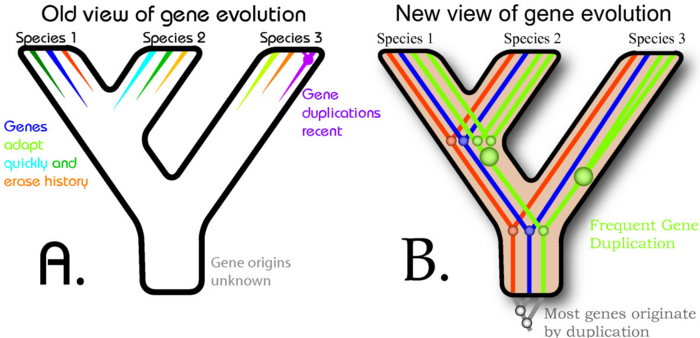Gene duplication: Difference between revisions
Jump to navigation
Jump to search


imported>Howard C. Berkowitz No edit summary |
mNo edit summary |
||
| (One intermediate revision by one other user not shown) | |||
| Line 1: | Line 1: | ||
{{subpages}} | {{subpages}} | ||
'''Gene duplication''' is the | '''Gene duplication''' is the insertion of the same [[gene]] into different parts of the [[genome]] of an [[organism]]. This typically occurs as the result of copying errors during [[cell division]], though it can also occur if an existing gene is incorporated again by means of [[horizontal gene transfer]]. | ||
{{Image|Gene-evolution-models.png|right|700px|Two views on the role of gene duplication in [[evolution]]. (A) Many [[20th century]] biologists viewed [[gene]]s as [[trait]]s of [[species (biology)|species]], exquisitely tuned to current utility. This resulted in the assumption that each species should, for the most part, possess different genes. Gene duplication was recognized, but was implicitly assumed to have occurred recently. (B) Many biologists now assume that most genes have their origins in gene duplication events, which happen throughout evolutionary history. As a result, many genes form families that have persisted for hundreds of millions of years.}} | {{Image|Gene-evolution-models.png|right|700px|Two views on the role of gene duplication in [[evolution]]. (A) Many [[20th century]] biologists viewed [[gene]]s as [[trait]]s of [[species (biology)|species]], exquisitely tuned to current utility. This resulted in the assumption that each species should, for the most part, possess different genes. Gene duplication was recognized, but was implicitly assumed to have occurred recently. (B) Many biologists now assume that most genes have their origins in gene duplication events, which happen throughout evolutionary history. As a result, many genes form families that have persisted for hundreds of millions of years.}}[[Category:Suggestion Bot Tag]] | ||
Latest revision as of 16:00, 20 August 2024
Gene duplication is the insertion of the same gene into different parts of the genome of an organism. This typically occurs as the result of copying errors during cell division, though it can also occur if an existing gene is incorporated again by means of horizontal gene transfer.

(CC) Image: Rose & Oakley, 2007
Two views on the role of gene duplication in evolution. (A) Many 20th century biologists viewed genes as traits of species, exquisitely tuned to current utility. This resulted in the assumption that each species should, for the most part, possess different genes. Gene duplication was recognized, but was implicitly assumed to have occurred recently. (B) Many biologists now assume that most genes have their origins in gene duplication events, which happen throughout evolutionary history. As a result, many genes form families that have persisted for hundreds of millions of years.
Two views on the role of gene duplication in evolution. (A) Many 20th century biologists viewed genes as traits of species, exquisitely tuned to current utility. This resulted in the assumption that each species should, for the most part, possess different genes. Gene duplication was recognized, but was implicitly assumed to have occurred recently. (B) Many biologists now assume that most genes have their origins in gene duplication events, which happen throughout evolutionary history. As a result, many genes form families that have persisted for hundreds of millions of years.